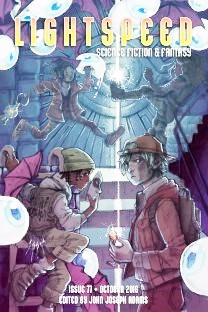“Fade to Red: Three Interviews about Sebold’s Mars Trilogy” by Stephen S. Power
Reviewed by Robert L Turner III
Steven S. Power creates a fascinating story in his “Fade to Red: Three Interviews about Sebold’s Mars Trilogy.” The story is told in the form of three interviews with a filmmaker, spaced over 20+ years. The interviews deal with three films that the filmmaker has created based on a discovery on Mars. In it we see an evolution of technology, the filmmaking art, and cultural change prompted by mankind learning that other intelligent species exist in the universe. The double distancing technique, an interview of a film of the discovery, works well to allow a slow release of information and to change a simple “we are not alone” story into a pleasure to read. Power shows a strong command of language and register without losing sight of the purpose of the story. Recommended.
I have mixed feelings about “Plea” by Mary Anne Mohanraj. The writing is solid and the story decent, but there is something about it…. “Plea” is set on a human colonized ocean world where those who have chosen to be genetically modified to better swim and fish are starting to be forced out of society. We are introduced to Gwen, Rose, their two sons and young daughter. As the story starts they are waiting in line to gain permission to immigrate to distant islands from the cetacean-like inhabitants of the world. Since the Erisians are completely peaceful, and empathic, the family must convince them that they are peaceful enough to immigrate. The author makes her metaphor very clear, and a bit heavy handed, with descriptions of a lesbian led family and the physical differences from unmodified humanity, yet the ending packs a strong punch. I am ambivalent as to whether this is good writing or emotional manipulation. Overall, a decent story.
Set in a world where dungeon crawling is a physically real event, Ivan, brother to a famous and now death crawler, is invited to get into the game by the new kid in school. “The Cavern of the Screaming Eye” takes this premise and blends it with the anxieties of the teen years as well as the personal tragedies of the main character. Jeremiah Tolbert’s world creation is interesting and while the general shape of the story is familiar, it is well done. I suspect that this is a world with a longer project intended and I think it would be a great place for a YA in the style of Steelheart.
“The Key to St. Medusa’s” by Kat Howard is an interesting if not excellent piece which explores isolation and revenge in a supernatural world. When the young protagonist, Agatha, decides to stop fighting her true self and become a witch, a clear nod to homosexuality, she is bundled off to a reform school that is in actuality a gentle and nourishing home for those who have supernatural talents. When Agatha and her friends discover that a man is serially marrying and then murdering magical women, they decide he must be stopped. The writing is very well done and the world creation is solid, however a key plot device is, despite the attempts at handwaivium, contrived and it weakens the piece. Overall, this is an enjoyable tale, but it doesn’t rise to the next level.
Robert Turner is a professor and longtime SF/F fan.
 Lightspeed #77, October 2016
Lightspeed #77, October 2016